What Is Clickbait?
Clickbait is a marketing and engagement strategy that uses sensationalist, misleading, withholding, or deceptive content to entice clicks and drive page views.
You’ve probably seen clickbait on YouTube in the form of thumbnails or titles. Or as ads on news articles.
Here’s what clickbait usually looks like:
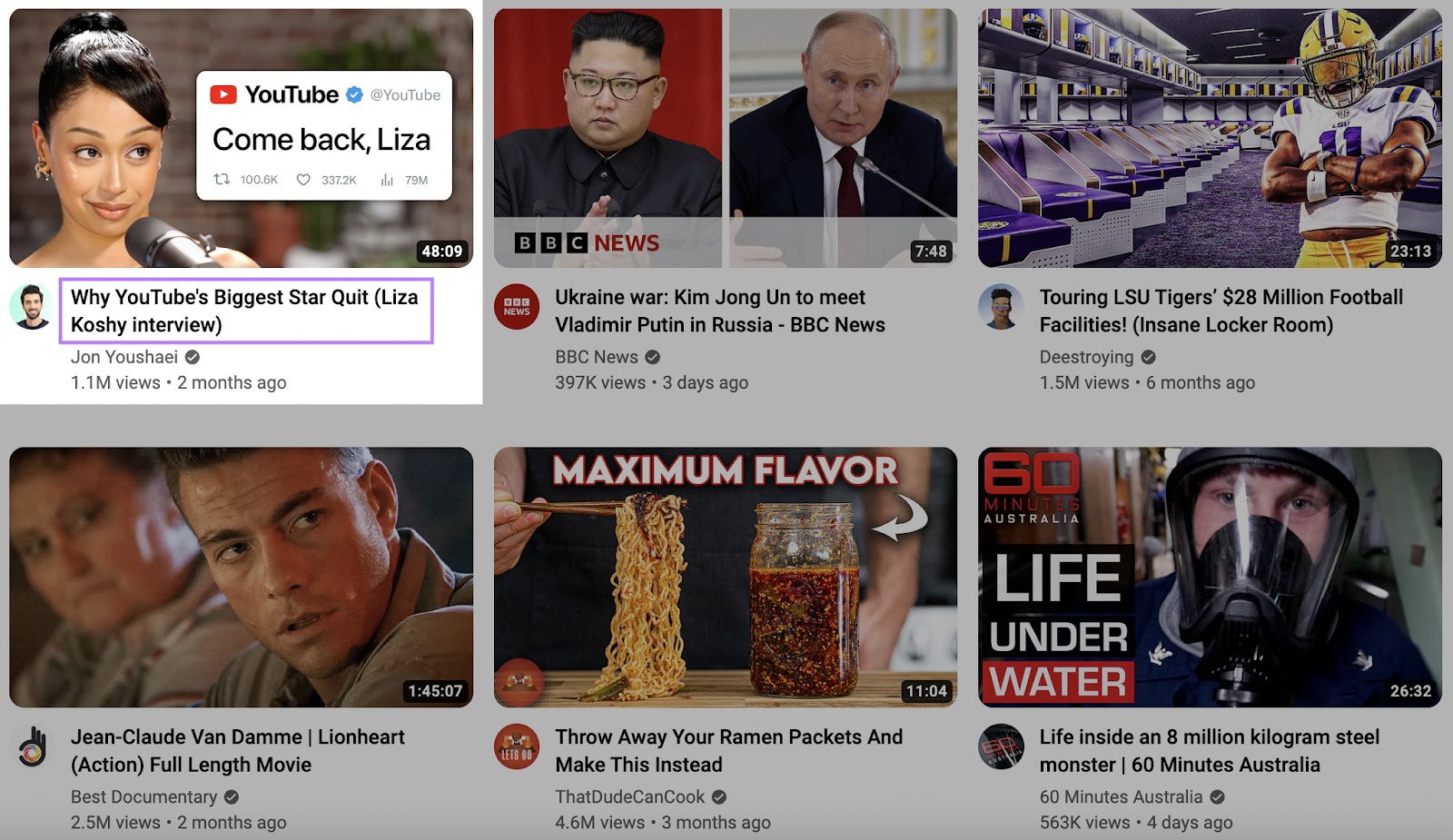
And here’s an example of clickbait content about celebrities:
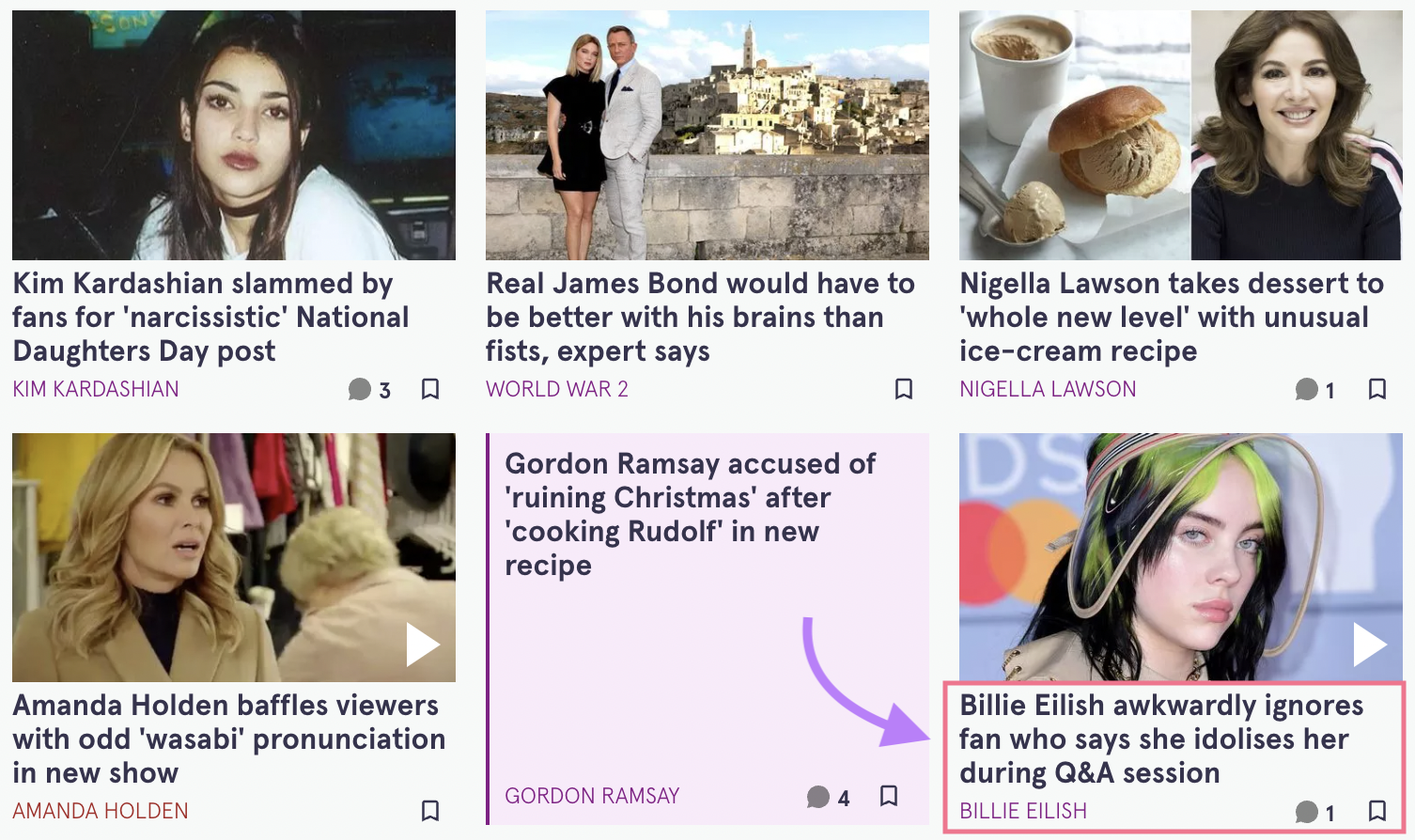
The problem? Clickbait content is usually far less exciting, accurate, or valuable than what was promised.
Let’s say you click on the article entitled, “Billie Eilish awkwardly ignores a fan who says she idolizes her during Q&A session.” Unfortunately, you’ll see a thin article with so many ads you can hardly read the content.
The story itself? It describes an online Q&A call where singer Billie Eilish wasn’t able to respond to a fan due to technical difficulties.
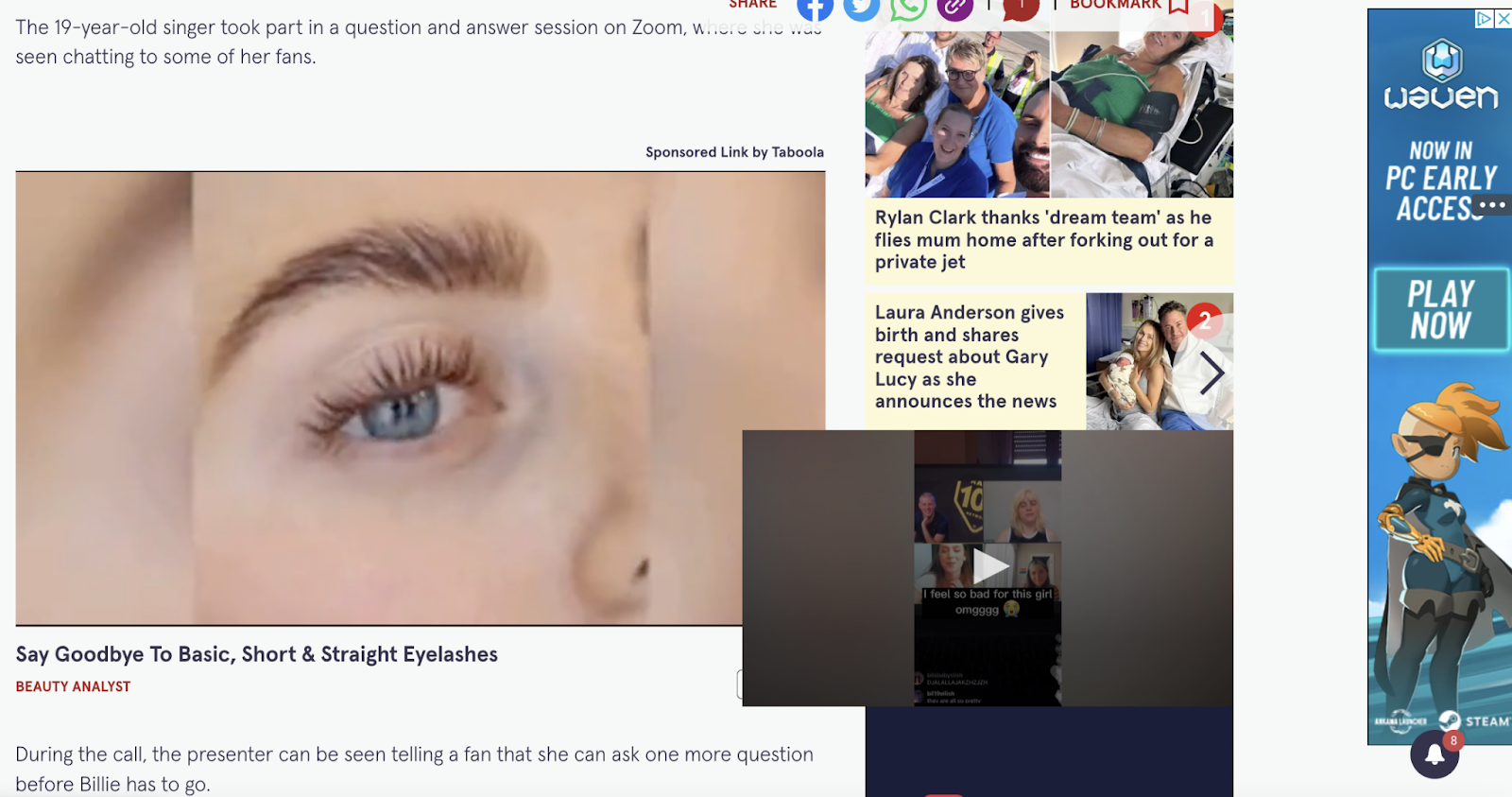
To better understand clickbait’s meaning, let’s delve into some examples.
3 Examples of Clickbait
Clickbait can appear in many formats. Here are three real-life clickbait examples.
1. Sensationalist Blog Titles
Some sensationalism in blog titles is OK. After all, you want your target audience to want to read your article.
But there’s a limit.
If you search for “insider beauty tips” on Google, one of the articles that might come up is from bellaUMMA entitled, “beauty insider: 101 BEAUTY TIPS YOU’LL REALLY WANT…”

That title is clickbait because:
- It’s in all caps
- There are too many tips
- The phrase “beauty tips you’ll really want” invokes curiosity to get searchers to click
But when you do click, you’ll find a surface-level list of widely known beauty advice.

Definitely not an “insider” guide with unique insights.
Instead of using a clickbait title, we recommend crafting an engaging and accurate headline that genuinely reflects your content’s value and purpose. (More on this later in the article.)
Pro tip: Get awesome headline ideas with our Free Title Generator. Just enter your topic or keyword and get an AI-generated catchy headline!
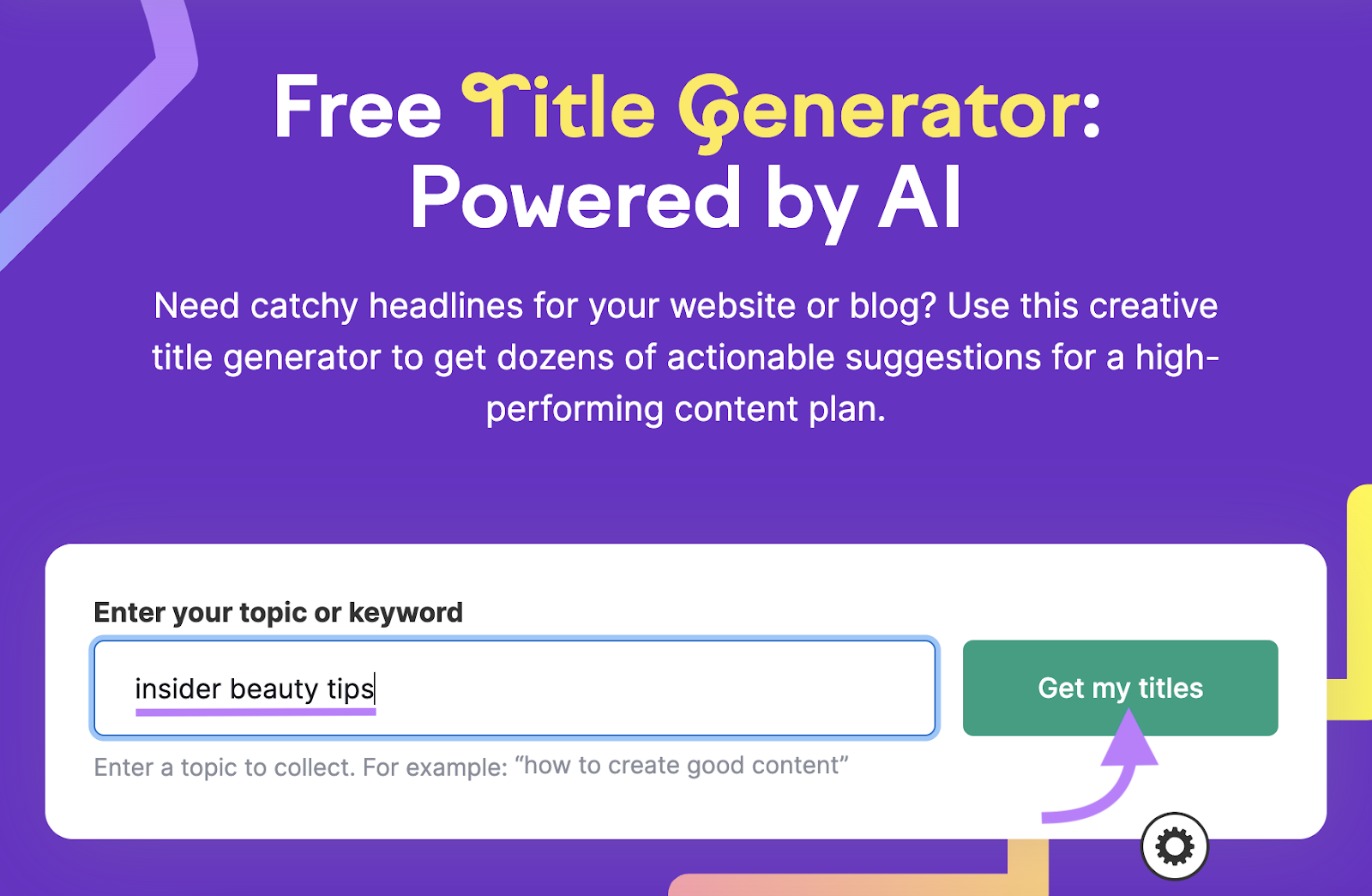
2. Over-the-Top YouTube Video Titles
The competitive nature of YouTube, paired with shorter attention spans and a desire for instant gratification, can drive some creators to use clickbait titles and thumbnails to boost views.
For example, if you search for “how to monetize Instagram,” one of the top videos is entitled “I’ve Made $500k from Faceless INSTAGRAM Accounts | How to go VIRAL and make passive income.”
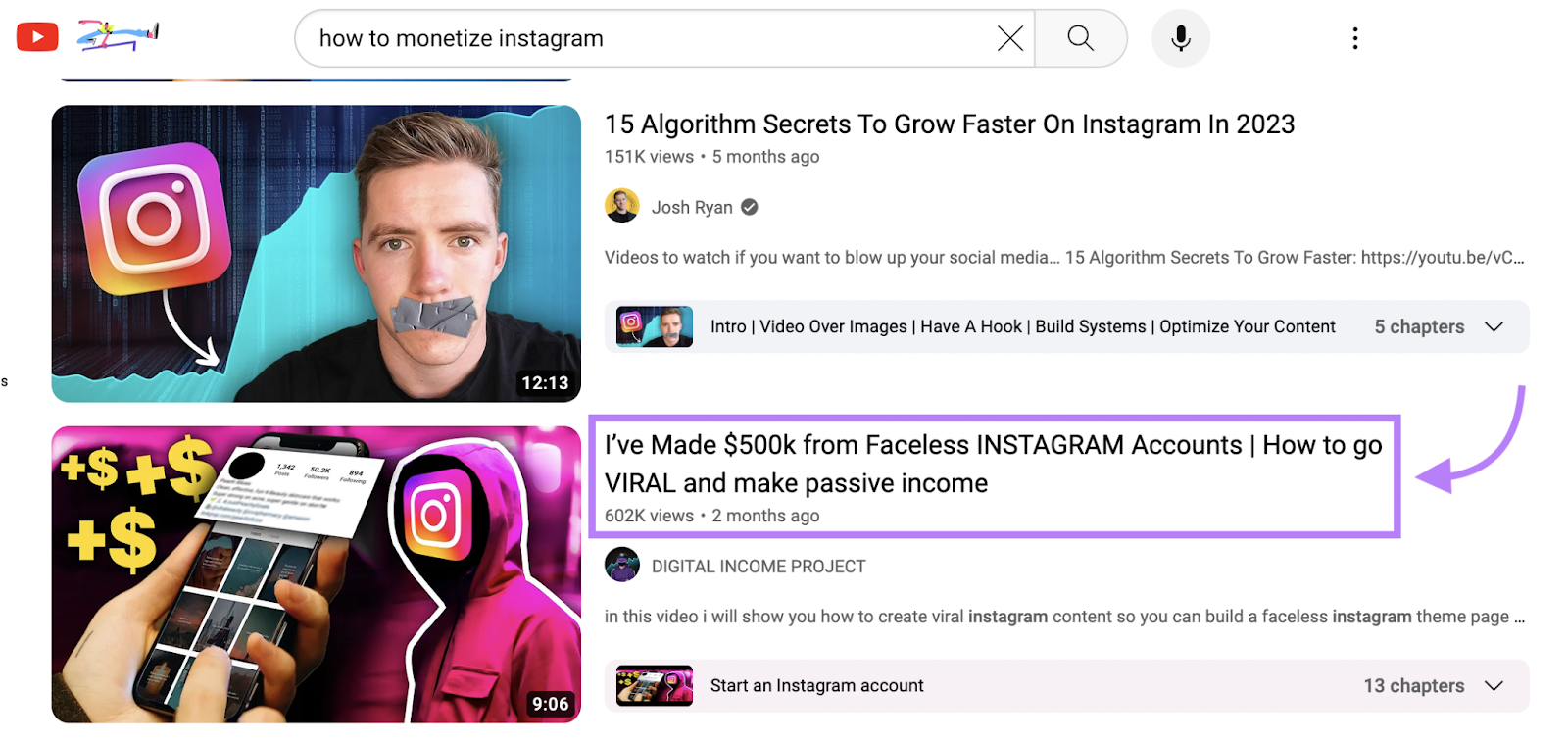
The video title is clickbait because:
- It uses an impressively high number to capture attention
- It capitalizes words like “VIRAL” and “INSTAGRAM” to stand out
- The phrase “make passive income” invokes curiosity to get viewers to click
But while the video does offer some instructions on how to create an Instagram account and research viral trends, it doesn’t provide any tips on how to make passive income, especially in the six-figure range.
Instead, it mostly lists out labor-intensive tactics that require a considerable time investment.
3. Entertainment News Article Headlines
Generally, people are curious about the lives of their favorite celebrities. But not every new article delivers on what its headline promises.
Yahoo! News, for example, has an article entitled, “Once A Huge Star, Today He Lives Alone in Westlake.”

This is an example of clickbait because the headline uses:
- Phrases like “you won’t believe your eyes” in the description and “once a huge star, today he lives alone” in the title to make you curious
- A less-than-flattering photo of Tom Selleck to create a sense of intrigue and concern
But when you click on the headline you’re directed to a long-winded blog post about more than 15 celebrities and their luxury houses.

Selleck isn’t even mentioned in the article. What you do see is lots of interstitial ads and outdated celebrity news.
Instead of relying on clickbait titles and unrelated information, we recommend crafting headlines and content that’s relevant to your reader’s search intent. Skip to how to do that.
Why Clickbait Works
Clickbait relies on a mixture of three psychological triggers to grab your attention:
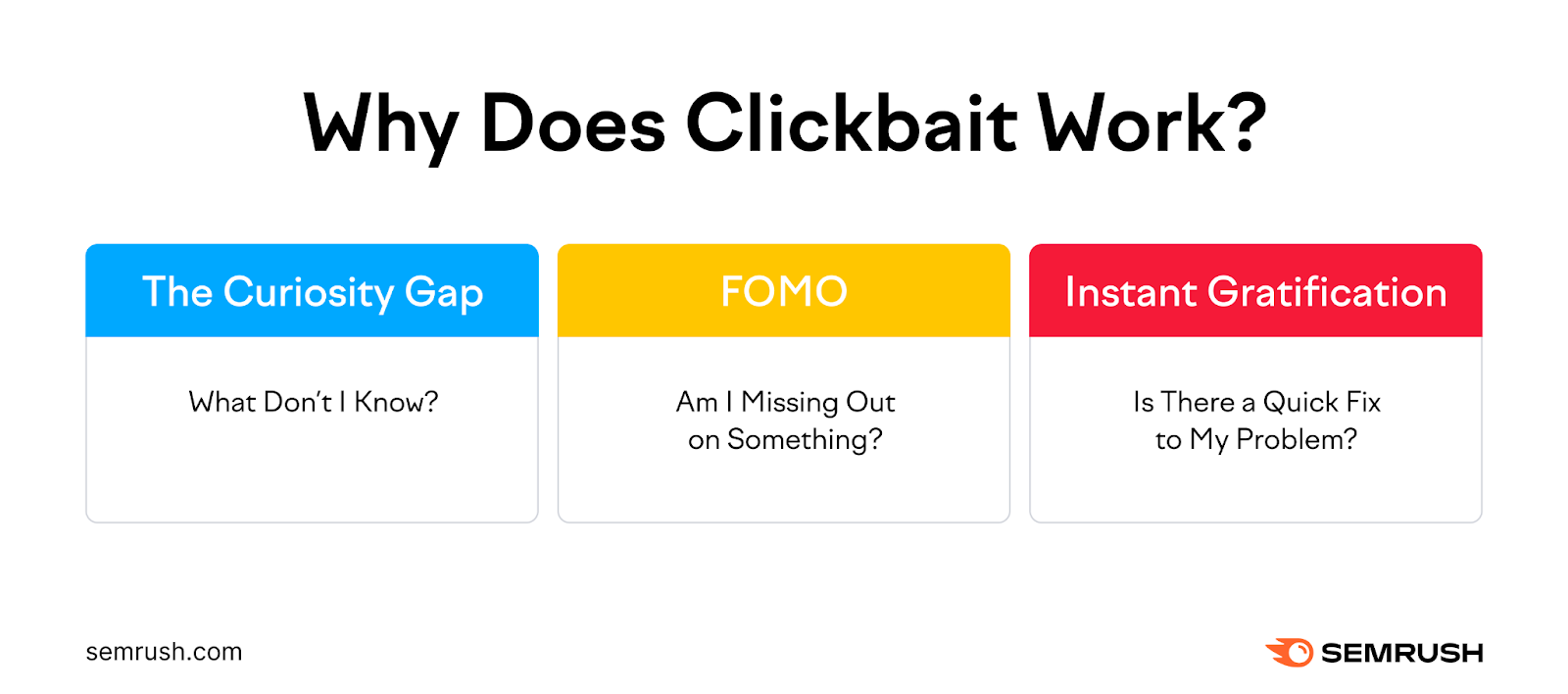
First, the “curiosity gap.” Which is the difference between what you know and what you want to know.
Clickbait artificially creates a sense of incompleteness or uncertainty using sensational or intriguing headlines. Which tease surprising, shocking, or “unknown” knowledge.
Since your brain naturally wants to close that gap and learn something new, you click on the link to read more.
Second, FOMO. Also known as the fear of missing out.
FOMO happens when you worry about potentially missing out on an experience, opportunity, or event that others enjoy.
Clickbait triggers this fear, urging you to click to avoid missing out on something significant, shocking, or entertaining. It capitalizes on your desire to be a part of the conversation.
Lastly, the natural need for instant gratification.
Clickbait headlines and articles promise easy solutions to your problems. And offer a quick fix to whatever issue you may be facing.
For example, if you’re looking for time management advice, a clickbait headline might read, “Boost your productivity overnight with this one simple trick!”
The allure of achieving instant productivity with minimal effort targets an impulse for immediate results, prompting you to click.
But is clickbait good or bad? And is it even effective?
Let’s find out.
3 Negative Impacts of Using Clickbait
Clickbait can help drive traffic to your website. But if it’s not followed by quality content that’s relevant and helpful to your reader, it can damage your website’s credibility.
When someone clicks on a headline or image that promises one thing and then finds out that the content is completely unrelated, that person loses trust in the brand.
Which can then lead to frustration and disappointment.
More specifically, here are three negative impacts of clickbait:
1. It Can Hurt Your Bottom Line
When a user clicks through to your website and doesn’t find what they’re looking for, they’ll quickly exit your page. They’re also less likely to interact further with your site.
This can damage your revenue potential by keeping you from:
- Showcasing your products and services
- Displaying more ads
- Encouraging link clicks that could lead to conversions
Relying on clickbait tactics increases the risk of missing out on converting visitors into leads and customers.
Not giving users what they want can also increase your bounce rate and decrease time on page.
While these metrics aren’t confirmed ranking factors, they reflect the user experience, your overall content quality, and whether you are satisfying the search intent.
2. It Erodes Trust and Lasting Audience Engagement
Providing visitors with content that fails to live up to its promises can damage your organization’s credibility and diminish their trust in you.
But when people look to your website as a source of truth, it helps you build a meaningful community and lasting audience engagement.
That, paired with a positive brand image, keeps people coming back. It’s the key to generating more returning visitors and influencing them to choose your product or service over the competitors’.
Ultimately, a strong foundation of credibility and reliability sets your brand apart. It can lead to sustained growth, increased customer loyalty, and referrals, all of which are essential for long-term success.
3. It Can Negatively Impact Rankings
Google now understands your website’s content better than ever.
It wants to provide searchers with the most relevant content for a given query. So it rewards content where “visitors feel they’ve had a satisfying experience.”
However:
- Primarily relying on clickbait titles to get traffic
- Providing thin, unhelpful, or low-quality content
- Not satisfying the search intent
Can negatively impact your rankings in the long run. To remedy that, make sure your content is helpful, authoritative, and easy to understand. And that it meets the user’s intent. (More on this soon.)
How to Break the Clickbait Cycle & Build Lasting Audience Engagement
If you want to build expertise, authority, and trust, start with crafting SEO-friendly, engaging headlines and aligning your content with search intent. Let’s take a look at these two tips in more detail.
1. Create SEO-friendly Titles
SEO-friendly headlines that are engaging and honest tell people what to expect from your article. They can also persuade your target audience to click by clearly demonstrating that your content has what they’re looking for.
More specifically, SEO-friendly titles that are relevant to the content and optimized for search engines can help you:
- Increase organic traffic
- Boost click-through-rate (CTR)
- Rank highly
- Tell Google what your content is about
- Set accurate expectations for readers
Clickbait titles, on the other hand:
- Employ emotional triggers such as curiosity, fear, or anger to capture your attention and entice you to click on the link
- Make exaggerated or sensational claims that aren’t supported by the actual content of the article
- Rely on misleading or vague language to tap into your desire for instant gratification, curiosity gap, and FOMO
- Use clickbait words and phrases like “Mind Blowing,” “Cringe-worthy,” “This weird trick,” or “This will shock you” to appeal to your innate desire for novelty or surprise
To write optimized titles, you first need to do keyword research.
Keyword research shows you target keywords you can include in your page’s title, headings, and content. Including your main keyword in your title helps search engines understand what your article is about.
Start by adding a seed keyword into Semrush’s Keyword Magic Tool. Then, select your target country and click “Search.”
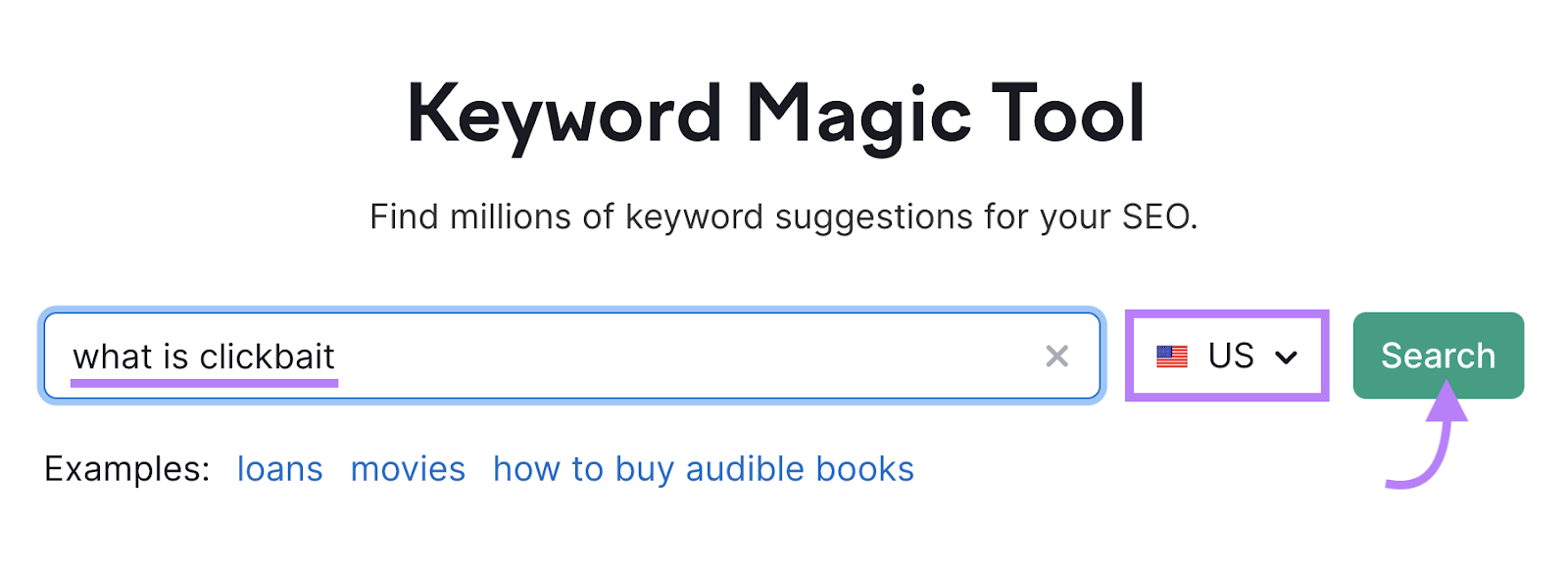
The tool returns a list of keyword suggestions and key metrics, like each keyword’s search volume, intent, and difficulty.
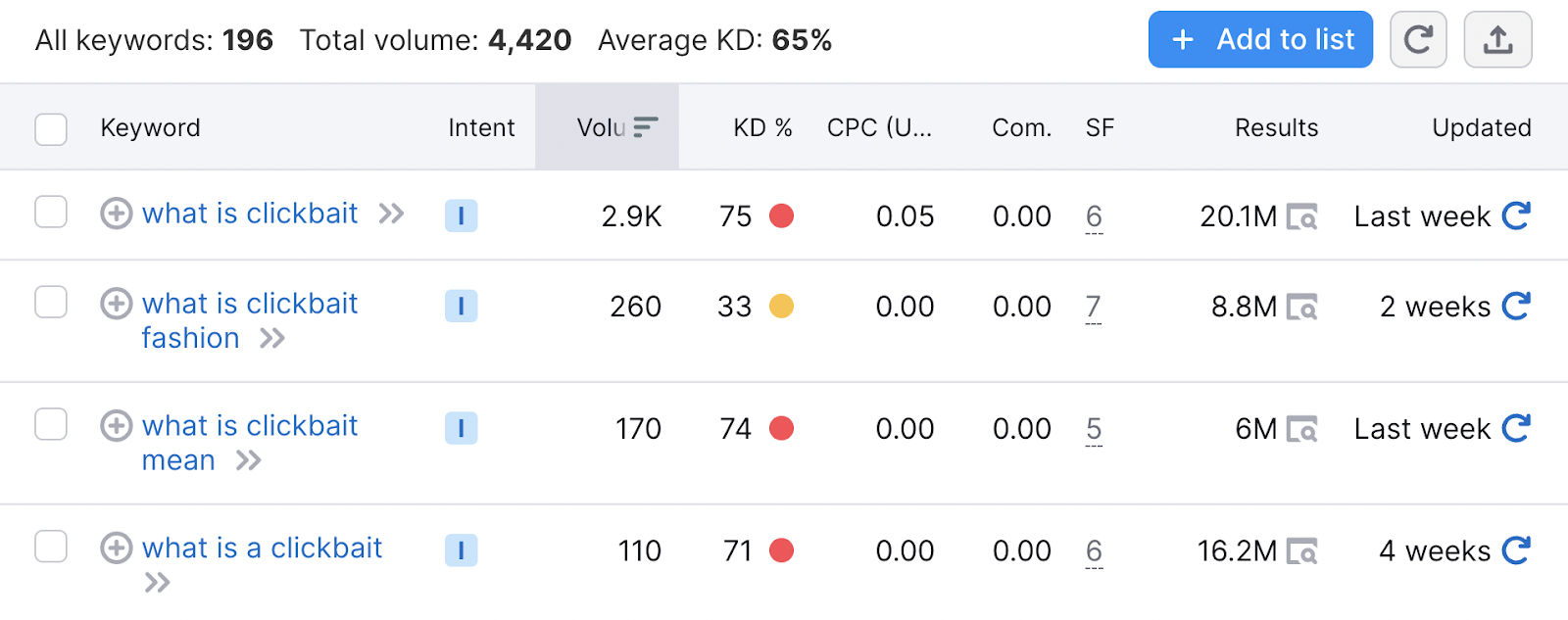
Here you can toggle the “Questions” view to see what users are asking about your topic. This can help you come up with a title that includes those questions.
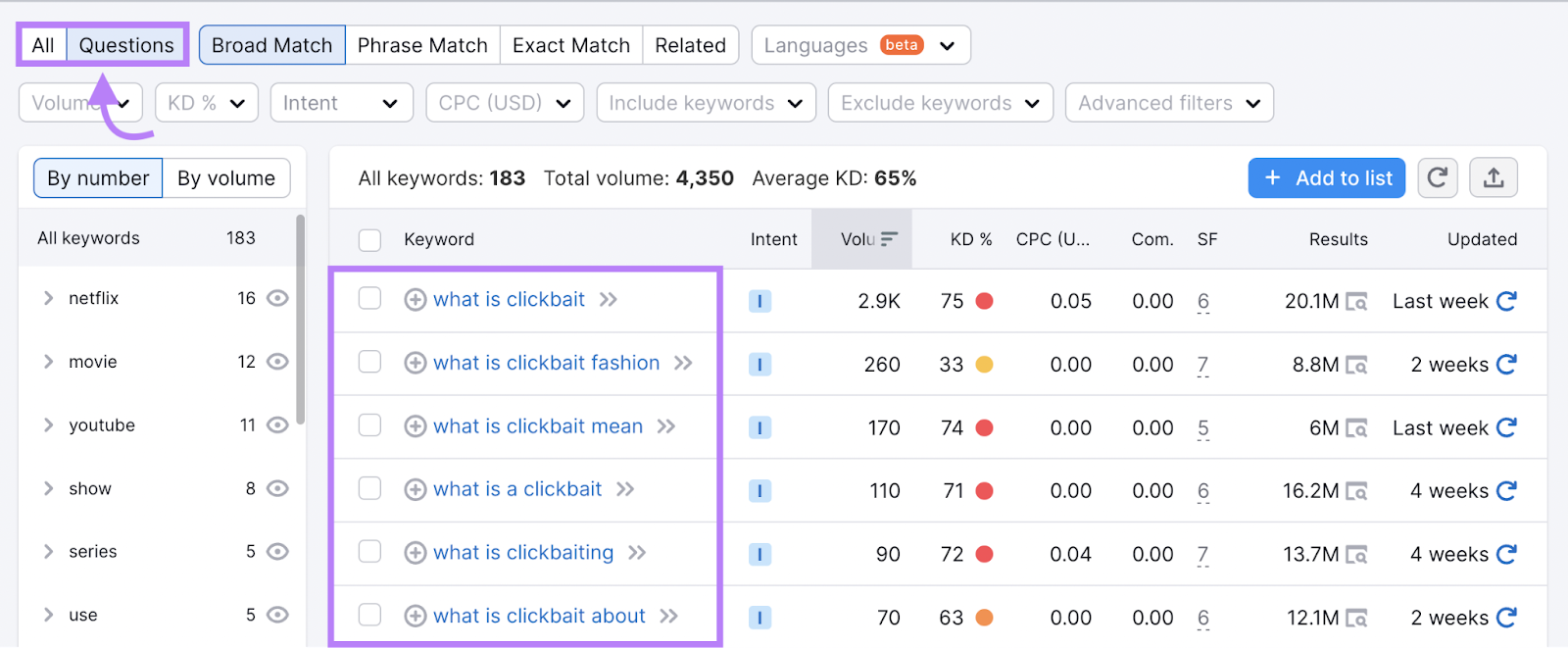
You can also toggle between:
- Broad Match for any variation of your seed keyword in any order. This helps you uncover related topics and potential long-tail keywords that might not have been on your radar.
- Exact Match for the exact keyword or phrase in an exact order. Exploring exact matches lets you understand the specific phrases users are searching for so you can tailor your content and headline to directly answer those search queries.
- Phrase Match for exact keyword or keyword phrase in various orders. With this, you can target more people than an exact match, but the traffic is still qualified.
- Related for a list of keywords that are similar and semantically connected to your seed keyword. This helps you cast a wider net and target a more diverse audience.
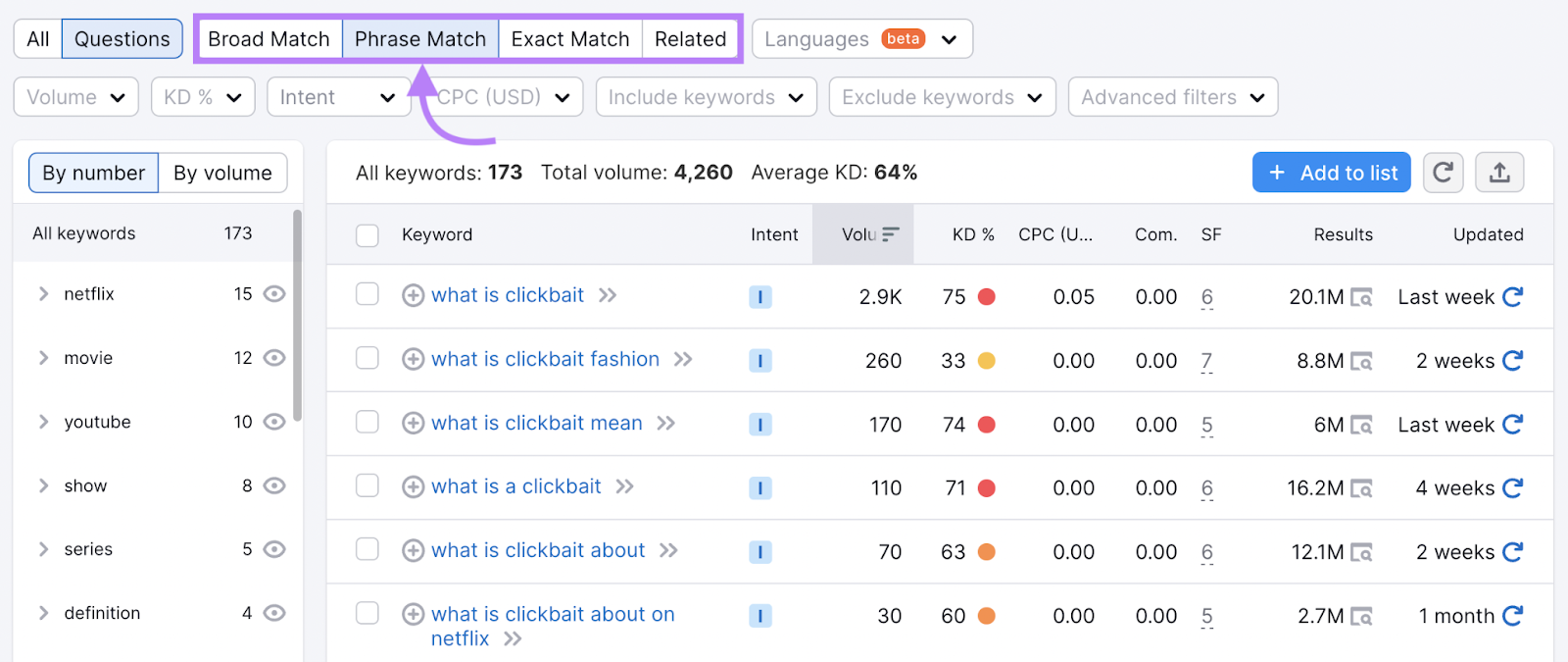
Pro tip: Save any potential keywords to your Keyword Manager. This tool automatically clusters your keywords into groups and prioritizes them by volume and difficulty. From here, you can compare them at a glance or send them to other tools in the suite.
Then, plug those keywords in Semrush’s free title generator. Start by entering your topic or keyword and clicking “Get my titles.”
In this case, we put “Is clickbait bad?” as our topic.
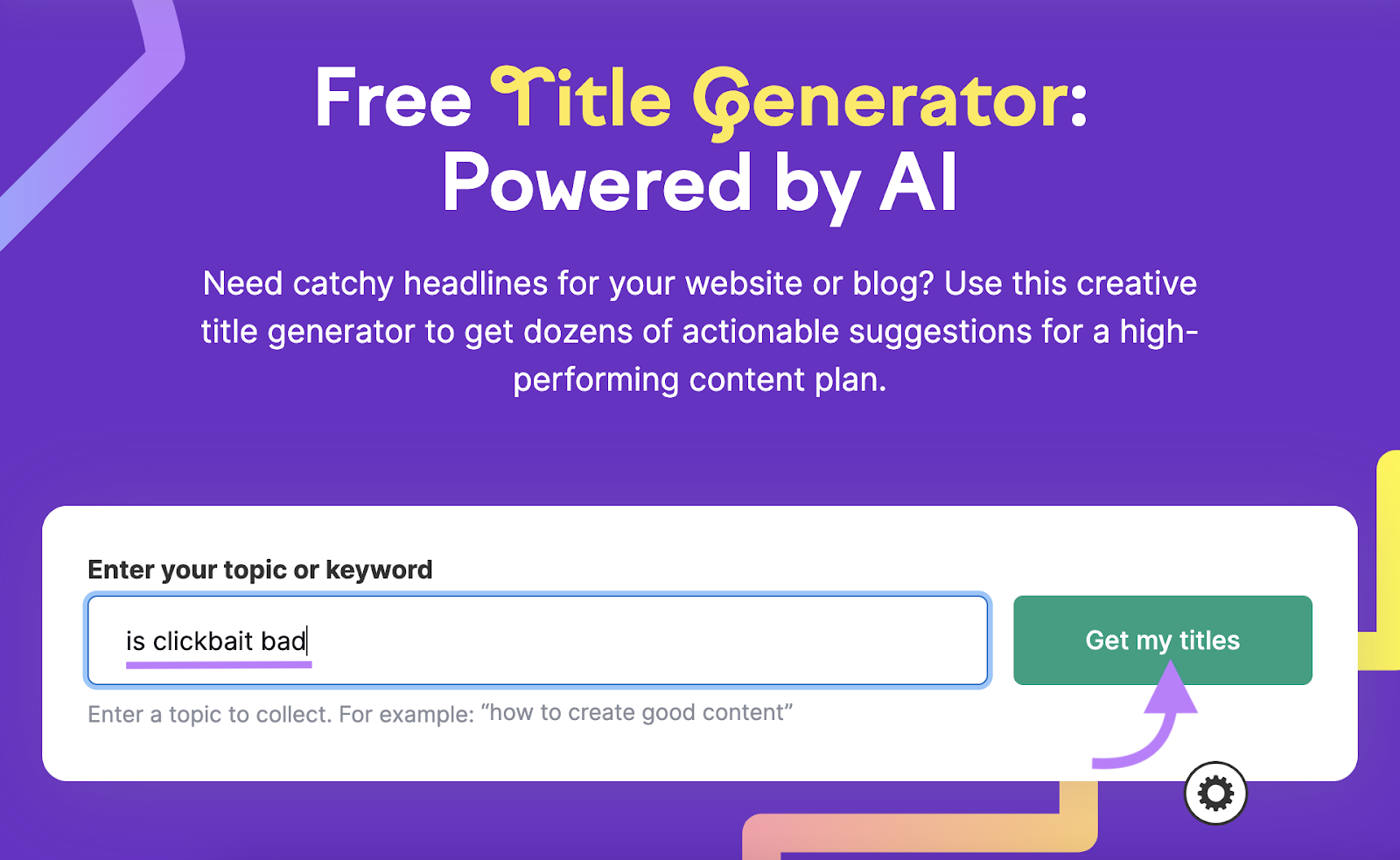
The AI Title Generator will automatically generate creative title suggestions in a variety of formats, including:
- Guides and how-tos
- Questions you’re teaching your audience about
- Listicles
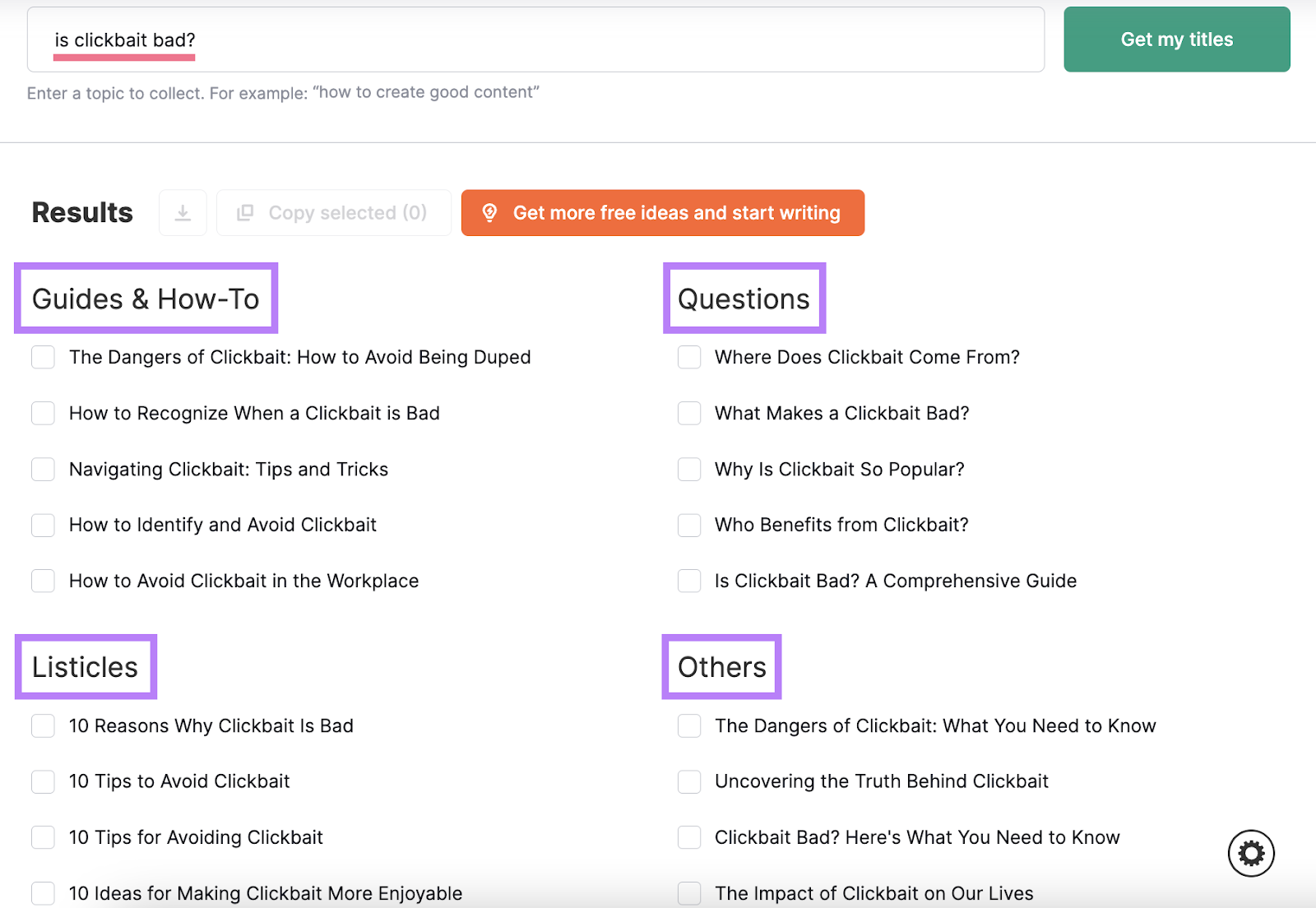
Pick your favorites by clicking on the box next to each option and add to your content plan by clicking the “Copy selected.” Or download them as a spreadsheet by clicking on the “Download” icon on the top left-hand side.
Finally, to transform your ideas into high-performing articles using AI, select “Get more free ideas and start writing.”
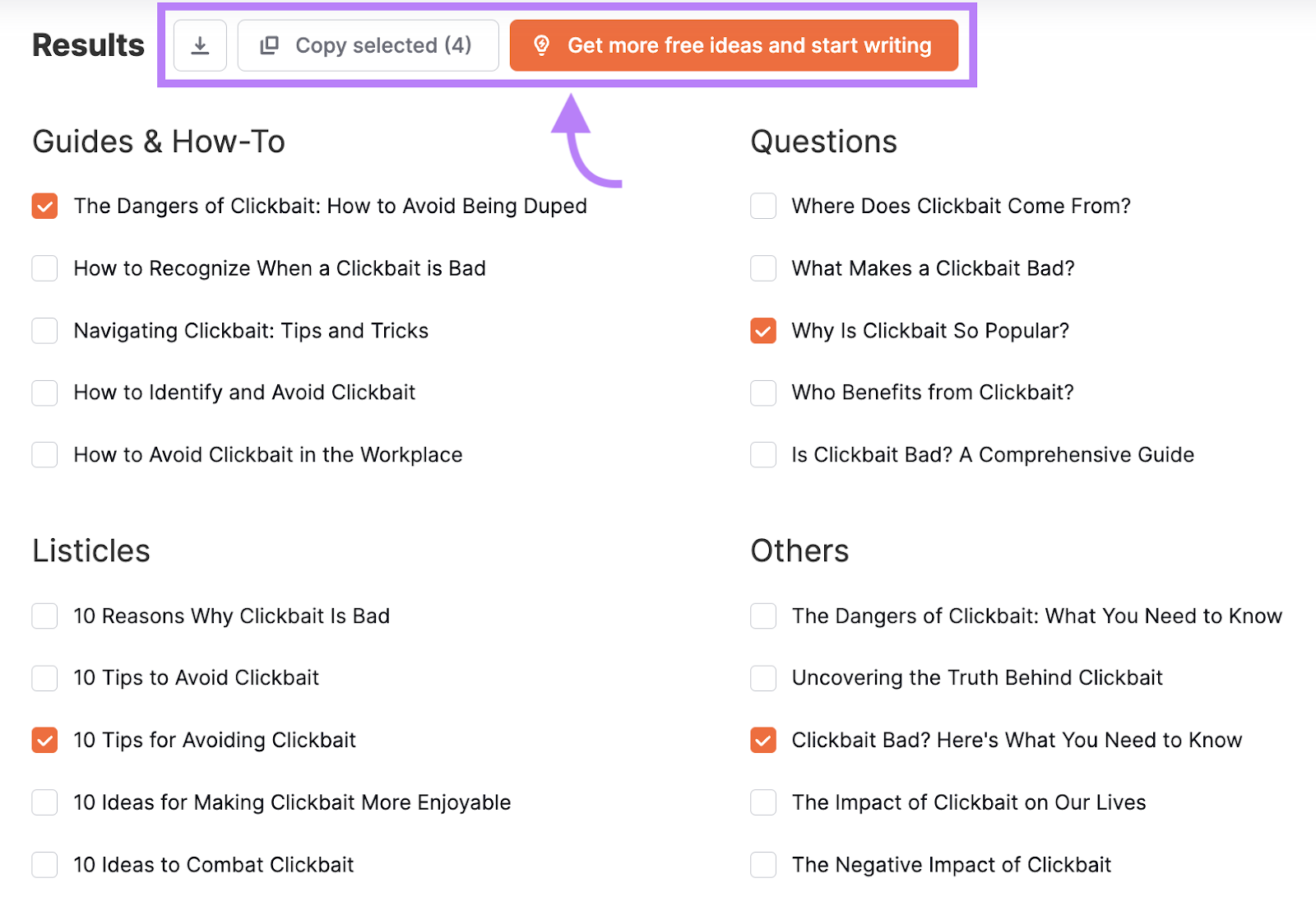
Pro tip: If you run ads and want catchy ad titles, check out the Headline Optimizer tool.
With this tool, you can generate ad headlines and ideas that are tied directly to your targeted keywords. You can also get real-time feedback, both from your customers and a paid audience panel, on which headlines are the most attention-grabbing.
Start by entering your primary keyword into the search bar and click “Search.”
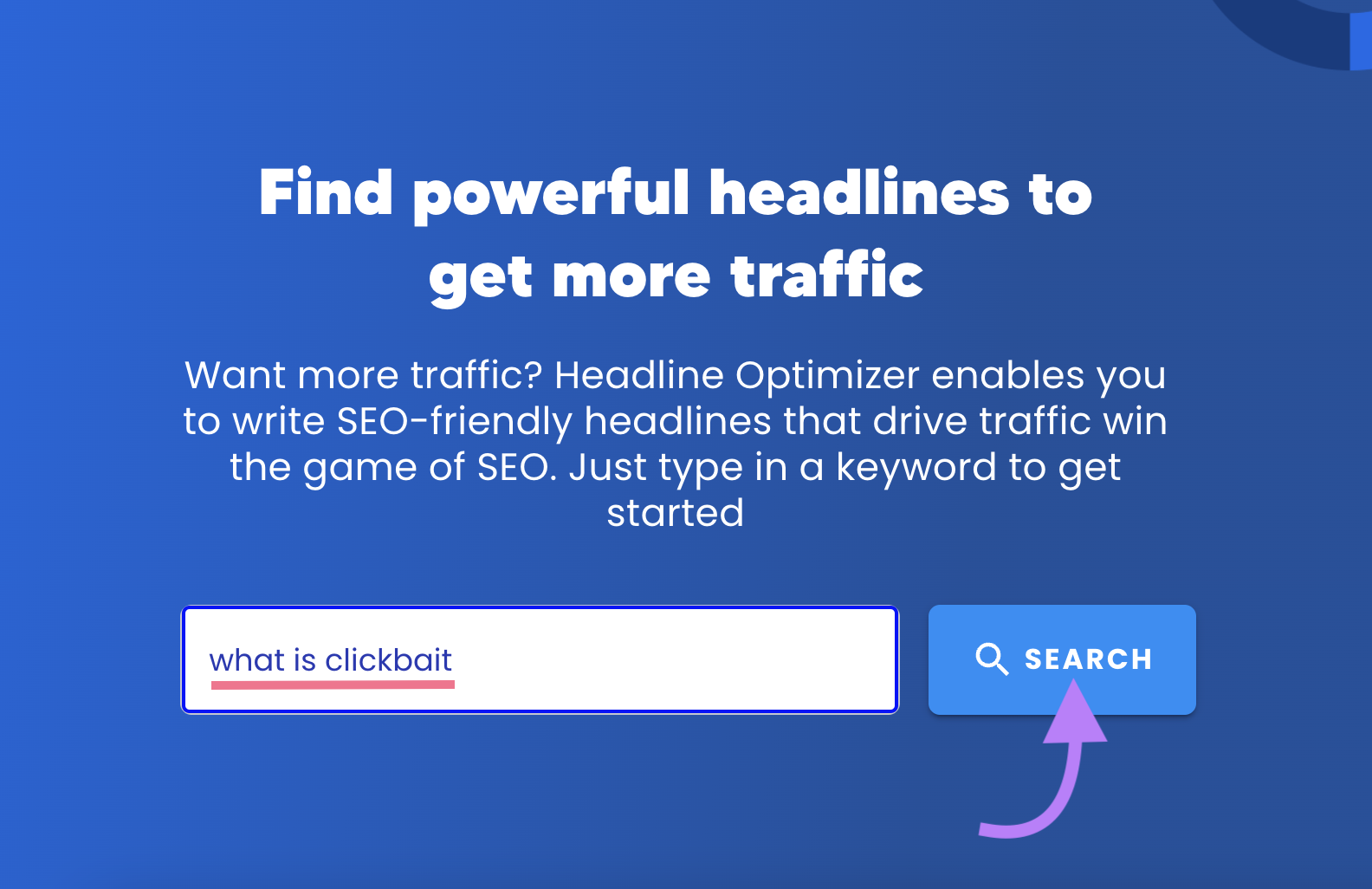
Once you’ve done that, you’ll be taken to a second screen where you’ll need to choose two suggested headlines from a list. Once you’ve done that, hit “Launch Test.”

Next, you can make adjustments to the name of your campaign, the test question, and A/B answer labels. When you’re done, hit “Save & Preview” to see how it will look to the testers, or “Save & Next” to head to the next screen.
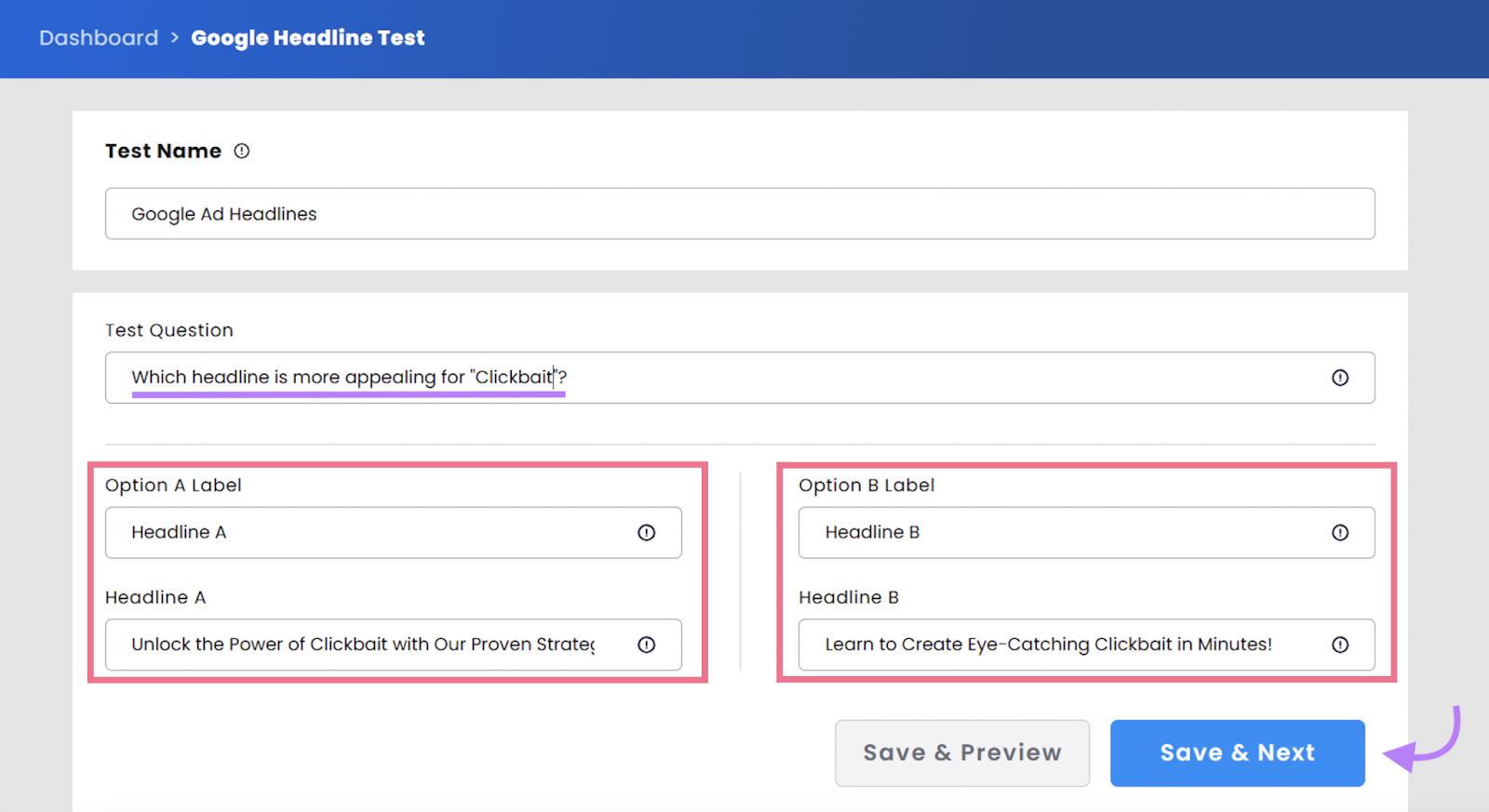
Now, you’ll need to select your test audience: an audience panel or your own audience. If you want to get feedback from the app’s **** of 500,000 participants, click “Setup Audience.”
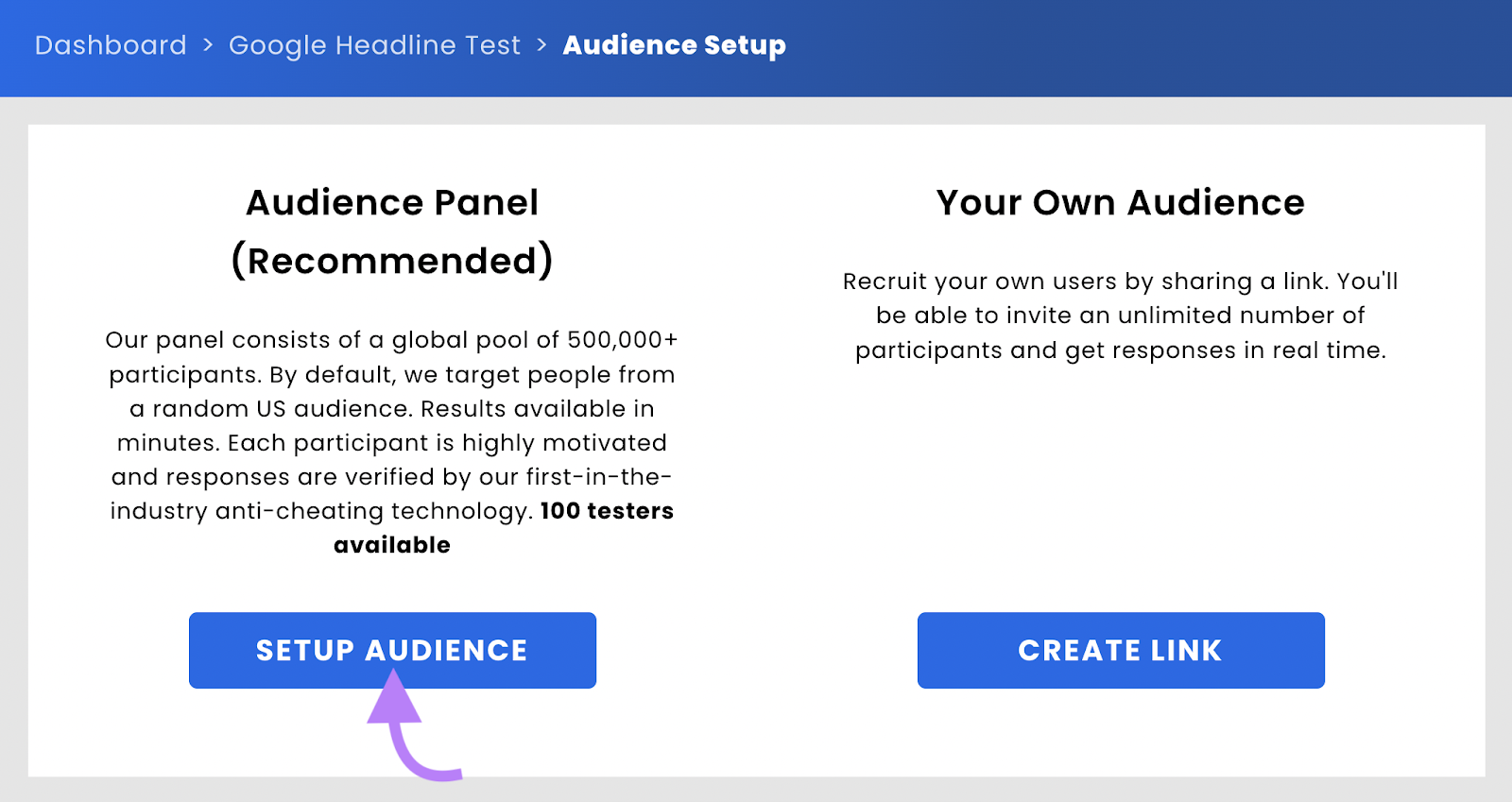
Select the number of testers you would like to submit your headline to. Once you’re happy with those settings, hit “Save & Preview” for a look at the final result, or “Save & Launch” to move on.
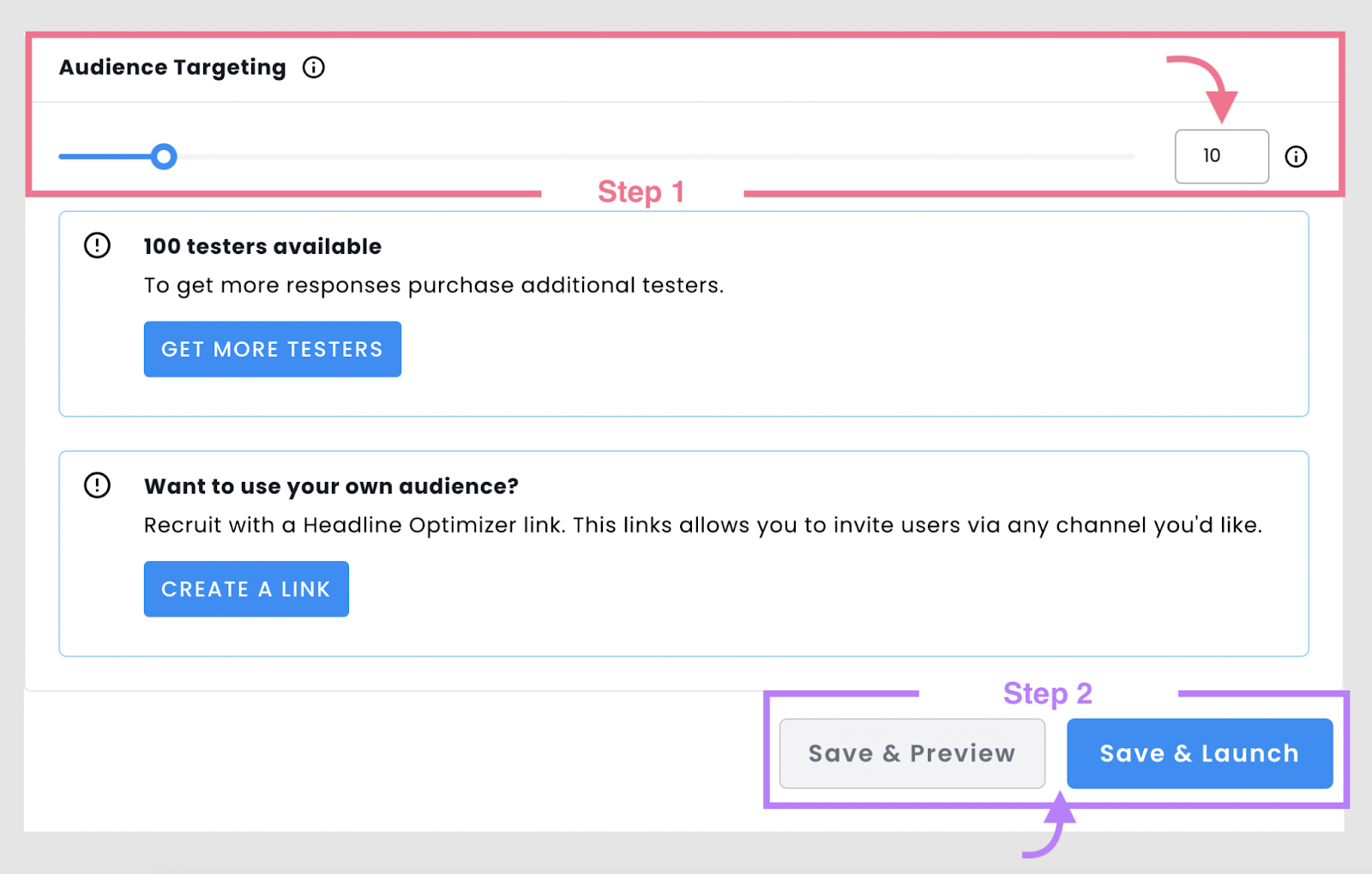
Once the test is out there, you’ll see a pop-up window prompting you to view your results. Click on your test name and you’ll be taken to your dashboard.

Click on your headline test to get an expanded view of your responses. This will tell you which of your SEO-optimized headings is more likely to get clicks. This way, you can avoid clickbait and still write an engaging headline.
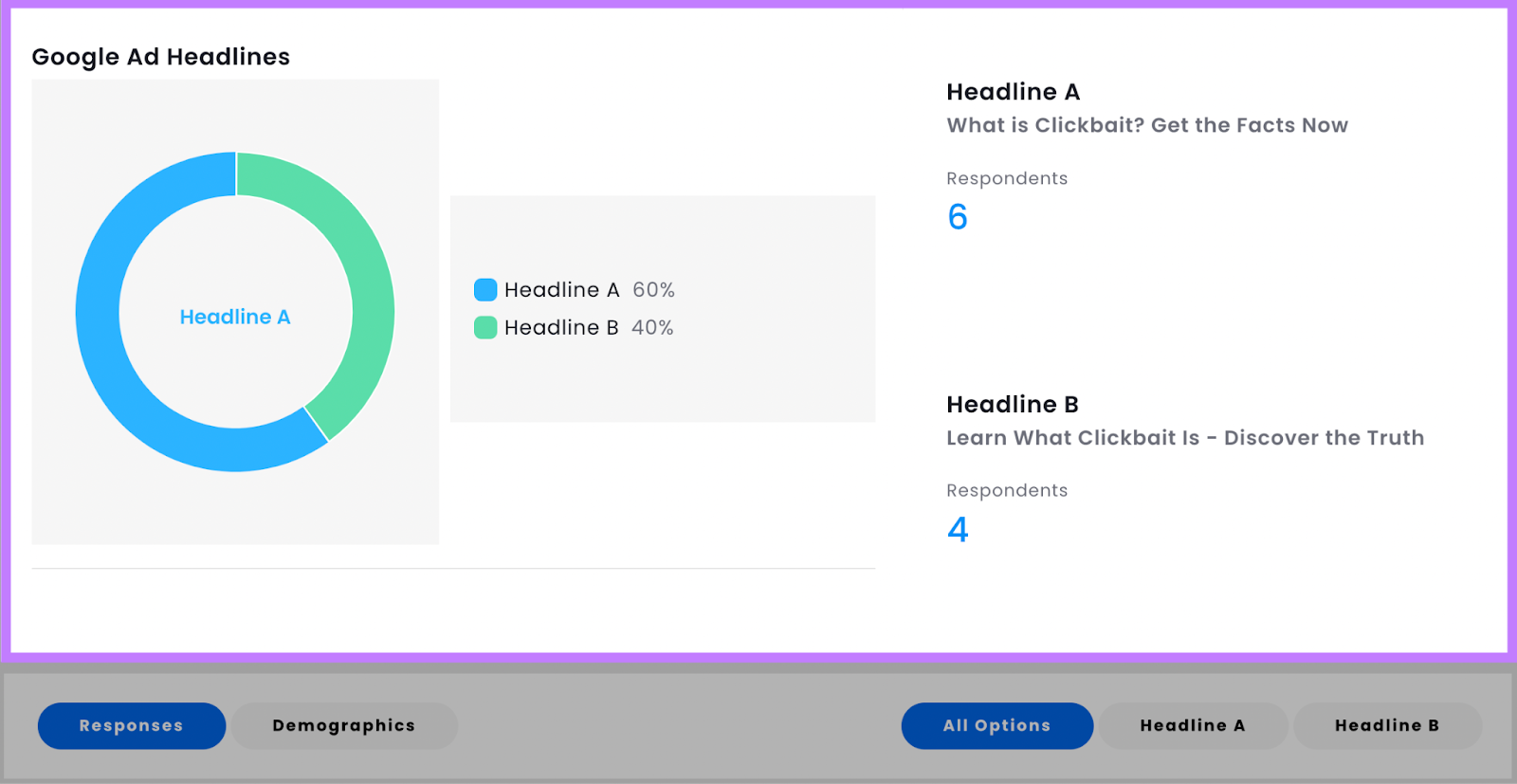
If you scroll down on that page, you can take a more in-depth look at your responses.

Further reading:
2. Match the Reader’s Search Intent with Your Content
Meeting search intent is one of the seven key components of great content. Content that accurately aligns with what users are searching for provides immediate value and relevance. Meeting search intent is also what sets your articles apart from clickbait and misleading content.
There are four main types of search intent:
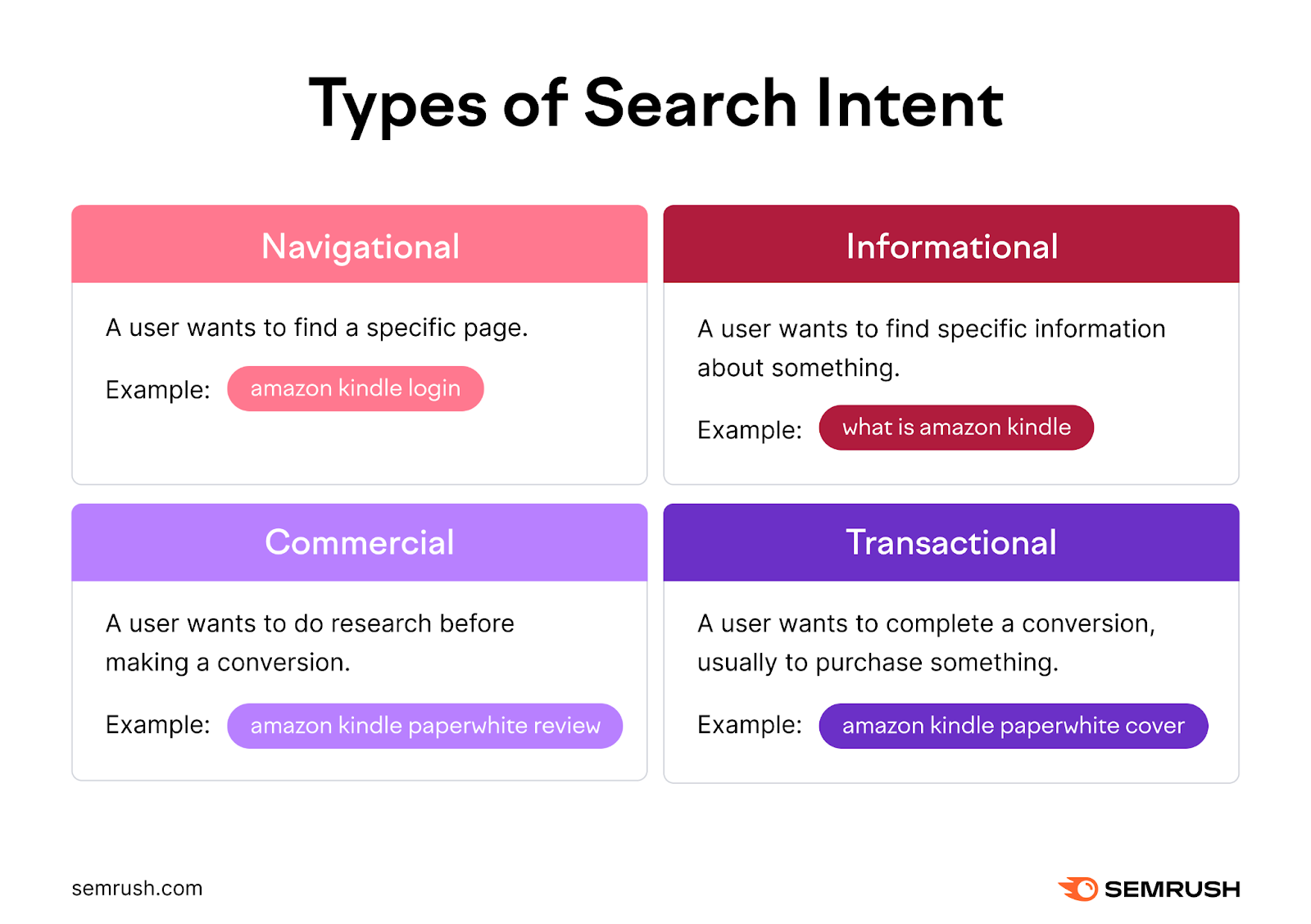
- Navigational intent: When users want to navigate to or around a specific website, they’ll likely add branded keywords in their search, like “amazon kindle login.” These searchers are less likely to fall for clickbait. They already know what they’re looking for and where to find it.
- Informational intent: If a user wants more information on a topic, they might ask questions or use keywords that indicate they’re looking for help. For example, “what is amazon kindle.” They are more likely to explore different sources and click on catchy or intriguing, even clickbait, headlines. That’s because they’re looking for general knowledge or answers to their questions.
- Commercial intent: This means users are looking for specific information about a product or service. So they’re likely to perform a search to compare the different options available. For example, “amazon kindle paperwhite review.” Clickbait can also affect users with commercial intent, depending on how specific or vague their search is.
Let’s say a user searches for “best e-readers 2023.” They might be tempted by a headline that claims to reveal previously unknown and “shocking” information about the newest kindle versus the newest nook. - Transactional Intent: Certain keywords or phrases signal that a user is ready to buy. For example, if they search for “amazon kindle paperwhite cover.” These users have made up their minds and are now searching for the best value proposition.
They can be susceptible to clickbait while looking for the best deals. Target these keywords with quality, SEO-friendly content that highlights your unique selling proposition. You can also target these keywords with ads, but make sure your CTA is clear and your landing page reflects what’s in the ad.
You can use Semrush’s Keyword Overview tool to identify the search intent for any given keyword and make sure your content gives them what they’re looking for.
Once you’re on the “Keyword Overview” page, type your keyword into the search bar. Then, click “Search.”
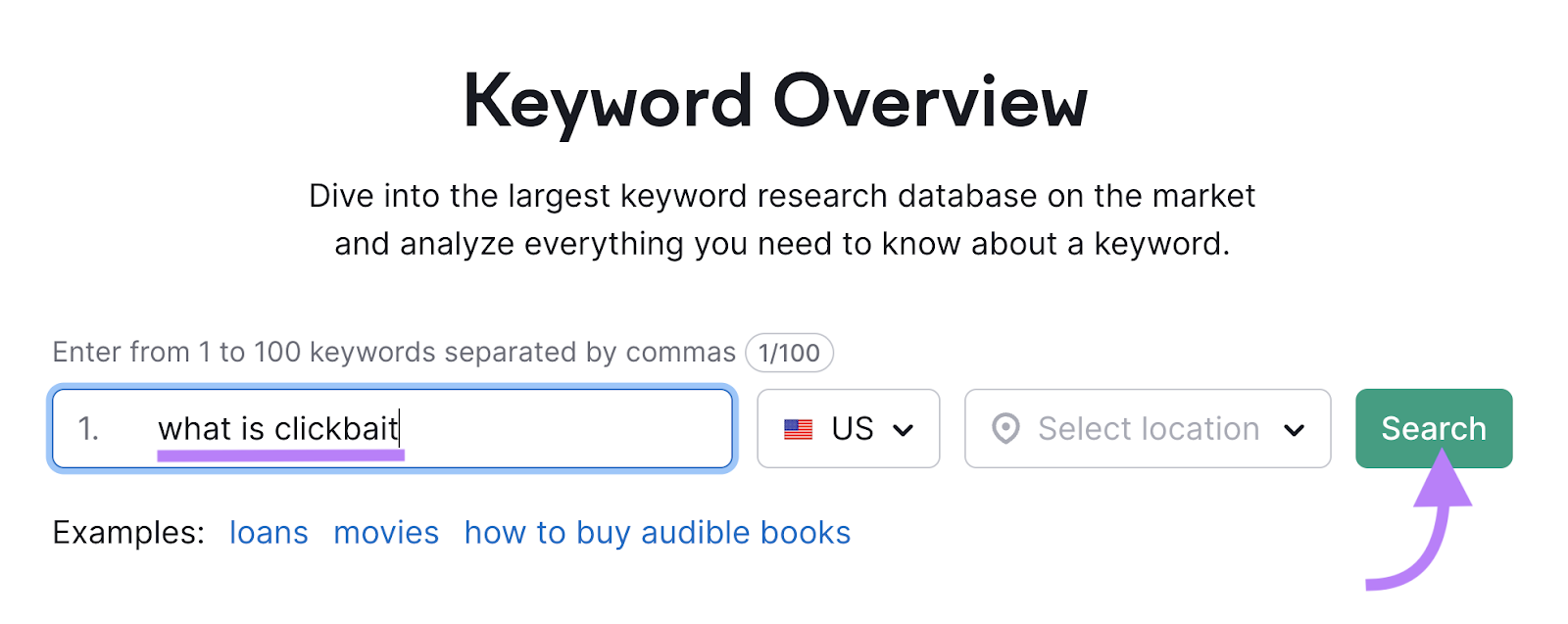
Next, you’ll see the “Keyword Overview” report for your query. Right at the top right-hand side of the report, you’ll see a widget labeled “Intent.”
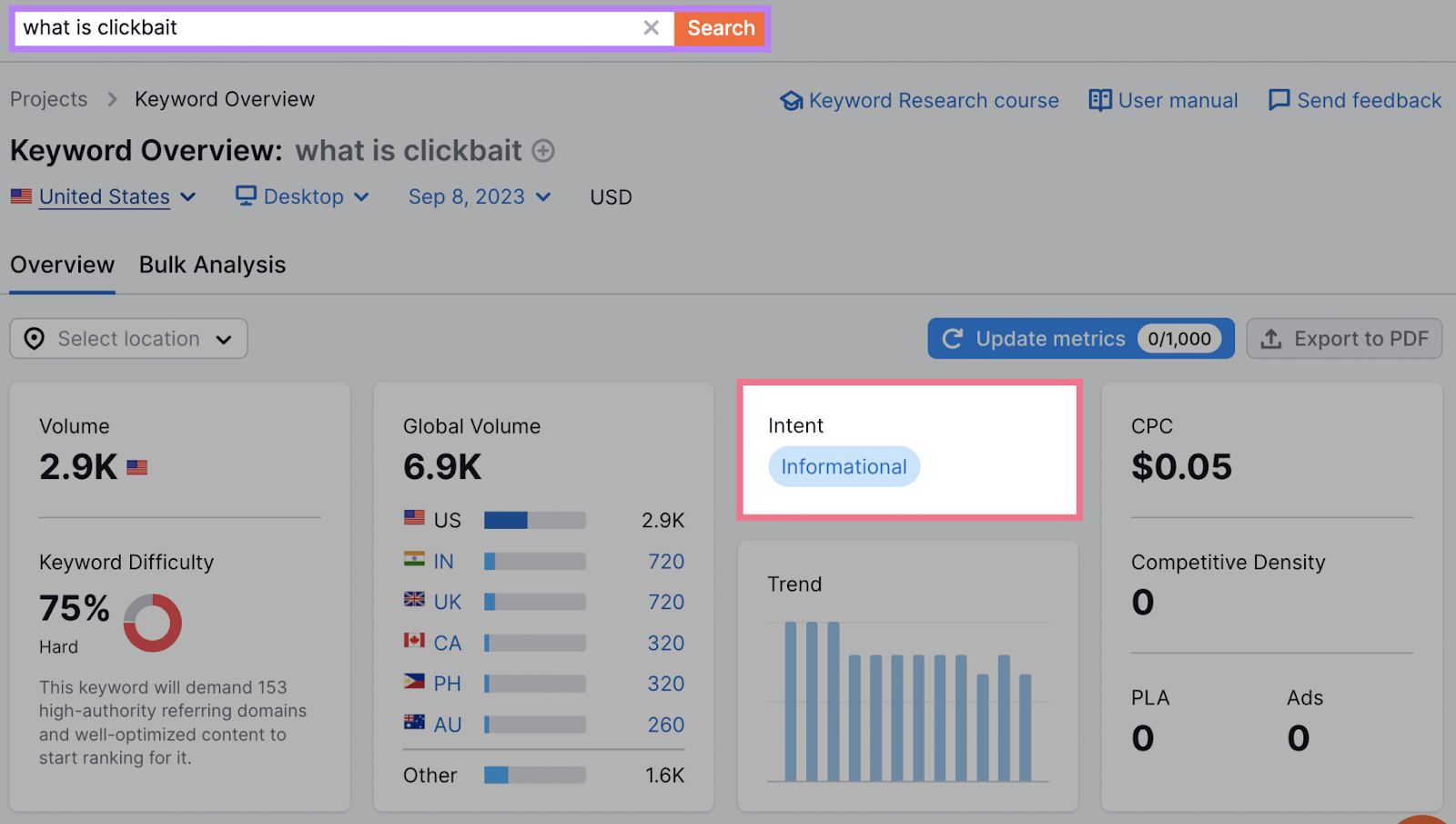
In this case, the intent for our keyword, “What is clickbait” is informational. This means that most of the content that rank on the first page of the SERPs focus on educating the reader on queries like “clickbait meaning,” clickbait examples, why it works, and how to avoid it.
Pro tip: Once you have your keywords and your search intent, write your headline and content in a way that’s relevant to that intent. You can use the SEO Writing Assistant to find and fix keyword stuffing in your content, and make sure it’s friendly to both web crawlers and readers.
Further reading:
Build Authority and Trust with Helpful, Optimized Content
Clickbait can help sites increase traffic in the short term. But it’s often not a sustainable, long-term growth strategy and can damage your reputation and authority if abused.
Instead, invest in strategies like creating strong and helpful content and optimized titles, to build trust, engage your audience, and drive meaningful traffic.
Our SEO Dashboard can help you monitor and optimize your website’s performance over the long term. With a comprehensive, single-page view of key website metrics and SEO trends, it helps you ensure that your content both attracts visitors and satisfies their search intent.
This way, you can foster a loyal and engaged audience that not only clicks but converts.
Source link : Semrush.com
